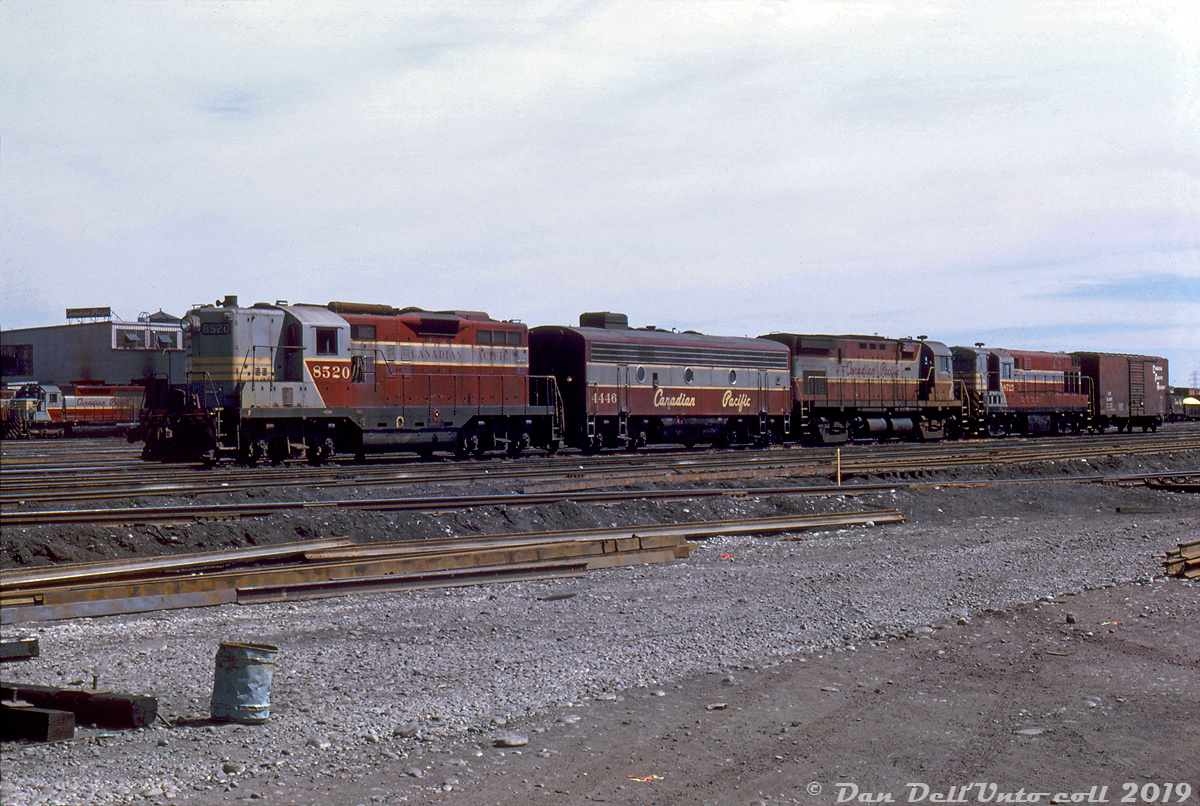|
Caption: This late 60's three-builder lashup is a nice show of the variety of power CP was running back then. CP steam generator-equipped GP9 8520, F7B 4446, C424 4228 and H16-44 8725 are seen together with a lone 40' boxcar at Alyth Yard in Calgary, noted as assigned to train #987. A much more modern 6-axle mainline unit, SD40 5542, is also visible at the diesel shop in the background. Multiple-unit (MU) standardization in the mid-1950's ensured different models from different builders could all operate together as one in a consist, with some oddball exceptions like Baldwins that featured an air-operated (pneumatic) throttle system.
CP's motive power policy was to assign blocks of units to certain shop locations for maintenance purposes, especially in the case of oddballs like the CLC and Baldwin fleets, to standardized on things like maintenance and parts on hand. Railfans often note the common saying of "CLC and GMD units in the west and MLWs in the east", but mainline units did stray. A 1970 motive power assignment sheet shows the MLW C424's were assigned to St. Luc for maintenance purposes, but they were common on transcontinental mainline runs early in their lives so could be found out west. Most of the GMD GP7/9's, F7B's and FP7's were assigned to Winnipeg and Alyth for maintenance purposes, but the F's were regulars in the east (less so the GP7/9's, which were better utilized on branchline and roadswitcher assignments out of their home terminals. MLW RS3/10/18's filled that role out east). The H16-44's and much of the opposed-piston FM/CLC fleet were assigned either Alyth or Nelson, and tended to stay on home territory. The GMD SD40's were assigned Alyth, originally purchased for coal service but found to have reliability issues that CP wasn't satisfied with (which was one reason they turned to MLW M630's for Locotrol coal service).
Small switcher units from both GMD and Alco/MLW such as SW8/900, SW1200RS and MLW S2/S3/S4 models could be found across the system assigned to various terminals and locations for local work, often the same regular units for years on end. And of course, CP's small fleet of Baldwins stayed in the far west (assigned to Vancouver & Victoria). For major overhaul work, wreck-rebuilds and such, all power typically headed to one of CP's two heavy backshops for work: Ogden Shops (Calgary) or Angus Shops (Montreal).
Doug Wingfield photo, Dan Dell'Unto collection slide.
|



Very interesting, I always look forward to photos from your collection and the accompanying history lesson!
Hi Dan, great history commentary and accompanying photograph. Loving the variations of the CPR maroon and grey paint scheme and the original large single headlight high on the nose of 8520, and the wonderful lash-up of various models and manufacturers. Thanks for sharing.